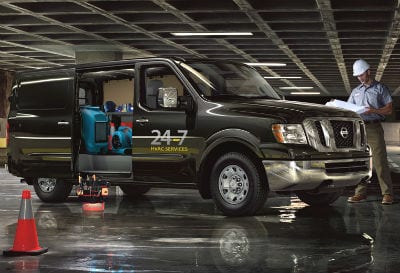Imagine you could start with a blank sheet of paper and design the perfect field service van. What would you change from the old standbys? What cool new features or little luxuries would you dare to hope for? That’s the situation Nissan faced when it decided to try its hand in the U.S. van market. We spoke with Mike Hobson, the director of marketing for Nissan commercial vehicles, to find out exactly what the Japanese automaker wanted to bring to its line of service vans.
 The SmartVan: Allyson Harwood, an editor at Motor Trend, described the Nissan NV to us as “cool,” not a word you usually associate with commercial vans. Was that what Nissan was aiming for?
The SmartVan: Allyson Harwood, an editor at Motor Trend, described the Nissan NV to us as “cool,” not a word you usually associate with commercial vans. Was that what Nissan was aiming for?
Mike Hobson: We were coming to the party in a very mature segment and we needed to do something different. So we looked at what was out there and really took the opportunity to innovate. I don’t know if ‘cool’ was necessarily the goal, but to be unique, different, and really hit the customer targets was definitely the goal.
Did you have field service folks in mind when you were designing these vans?
Absolutely, we had a spectrum of customers in mind. With regards to the NV, the target customer was primarily an owner/operator [type]. So we set out to lay the groundwork for a vehicle that could apply to the service industry, to the delivery industry, to installs, plumbing, HVAC, locksmiths, et cetera.
We break field service down further still into two subcategories: installation, and service itself. On the installation side, they’re usually carrying heavier equipment and doing heavier-duty cycles in their vehicles. On the service side, usually it’s inspections of installations or it’s calling on customers or those kinds of things. So with the NV, we have the NV cargo van, which is the full-sized van. And we’re going to come out with NV200, which is going to start in the market at the end of this calendar year.
Describe some of the unique features of these vans.
We were able to start with a design that was more pickup-like, with the engine out in front, and that cleared out the foot well and it gave us a lot more interior comfort in the vehicle. Beyond that, we also have the “mobile office.”
One of the key ideas for this type of customer was the reality that they live in their vehicle — their office is their vehicle — so the “mobile office” concept is a way for us to incorporate the capabilities of working from their home office actually in the field. It includes this large central console with power ports for 110 volts, lockable storage for laptops, hanging file folders … the list goes on and on.
This market has dominated by U.S. brands like GM and Ford for quite some time. What do you think it will take for Japanese vans to compete?
I believe everybody was a little bit surprised when we brought out the NV cargo van and now the NV passenger van, which is going into production this month. Because we were able to innovate as we talked about, we’re bringing things to the table that other companies have not been able to do or have no offered in the past. But for a Japanese brand, yeah, we have to prove ourselves in that market space.
We’ve been out in the market now for about a year. We are definitely gaining traction very quickly with a lot of customers and also some larger fleets as well. It took people a little while because they don’t want to take a chance with a vehicle that’s their primary source of income, so people will wait and see how things go. But we’ve really been proving ourselves, I think, one customer at a time.
Are there any other advantages of the NV line for field service firms that you’d like to highlight?
We have a commercial incentive program that’s available to all purchasers of the vehicle, and that gives the customer the opportunity to select either a rack and bin package, similar to what Ford and G.M. offer, but we also have other options. We have a full graphics package as one of the choices. That is a turnkey solution where they can customize graphics directly, one vehicle at a time, and have those graphics ordered and installed at no charge to them, falling within the parameters of the program. That has been really well received as well.

I wish my boss could afford to put me in one of these.
Do they have a natural gas model? Can you add ladders on top if so how large.
Nissan is doing a lot to make the partition safer, but it still does not comply with Federal Standards. Nissan should understand that partitions do not help driver safety in assaults. Who wants a device that makes it necessary to use a gun for a robbery?? We prefer the kinder, gentler days of knife attacks.